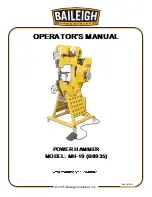
OPERATION
Before starting work it is advisable to test the
work surface for the ideal temperature to use.
The table below gives an indication of the likely
heat settings required but always start with the
low heat setting. All applications, with the
exception of removing paint from window
frames, can be performed without using a
nozzle, however for best results nozzles are
recommended.
Nozzles
The gun is supplied with four different shaped
nozzles, which can be used as follows:
Concentrator nozzle -
G84
Directs a
concentrated heat
flow to the work
surface.
Ideal for removing
paint in awkward
corners, crevices,
mouldings, beading
or architraves.
Glass protection
nozzle - G89
Deflects the heat
away from glass
or other fragile
areas.
Ideal for windowsills,
ledges, frames and
base boards.
Hook nozzle - G87
Disperses the heat
flow evenly around
the whole work
surface.
Ideal for defrosting
frozen pipes,
soldering pipe work,
bending plastics or
heat shrinking
electrical insulating
tubing.
Deflector nozzle - G88
Directs a long, narrow
heat pattern to the
work surface.
Ideal for removing paint
or varnish from large,
flat surfaces such as
base boards, doors,
stairs etc.
It should be used in
conjunction with a flat
scraper.
Vinyl tiles can be removed by softening the
tile and adhesive.
Removing paint - general
Do not heat the paint for too long as this
will burn the paint, making it difficult to
remove.
1.Choose the required nozzle and fit
onto the heat outlet.
2.Hold the gun with nozzle approximately
50mm (2”) from surface of the paintwork.
3.Starting with the low heat setting, move
the gun slowly backwards and forwards
until the paint blisters and bubbles.
4.Immediately remove the paint with a
scraper or shavehook.
5.Aim to heat the paint just ahead of the
scraper so that you can develop a
continuous action.
Removing paint from window frames
WARNING – Glass can break easily when
heated.
1.Use the glass protection nozzle.
2.Ensure the nozzle is facing the correct
way to deflect heat away from the
glass before you switch on the heat
gun.
3.Rotate the gun/nozzle 90º as you move
to horizontal or vertical bead (take care it
could be hot!).
4.Paint can be removed by using a
shavehook and/or a soft wire brush.
Maintenance
Always allow the machine to cool down (before
storing) and disconnect from the power supply.
The heat gun should be cleaned before being
stored away by wiping over with a clean damp
cloth.
DO NOT USE CHEMICALS.
Ensure that
the ventilation slots are not blocked.
Trouble Shooting
If a problem occurs always switch off the
unit immediately and disconnect from
power supply.
My unit fails to work?
If you are using an extension cable it must be
fully unwound and rated at 15 amps capacity.
Refer to ʻThermal cut outʼ on page 2.
3
Concentrator nozzle
Glass
protection nozzle
G84
G89
G87
G88
Hook nozzle
Deflector nozzle
Low
High
Welding plastic
Paint stripping
Bending plastic
Defrosting pipes
Heat shrinking
plastic
Removing vinyl
floor tiles
Soldering
Lighting BBQs
Suggested Ratings
G135.qxd:G29 09/05.qxd 28/7/11 09:22 Page 3
All manuals and user guides at all-guides.com






















